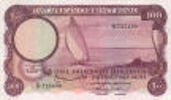The East Africa Currency Board of Nairobi was established in December 1919 to provide a medium of exchange for British East Africa (Kenya, Tanganyika and Uganda). In 1923, East African Shillings replaced the German marks that had circulated in Tanganyika until then. The Government of the East Africa Protectorate had issued banknotes between 1905 and 1920. The currency was also used during World War II in Ethiopia and in Italian Somaliland, and in British Somaliland and Aden (Yemen) beginning in 1947 when India gained its independence.
The British East African Rupee (XEAR) replaced the Indian Rupee in Africa with 1 Rupee equal to 1.5 Shillings, and divisible into 100 Cents. In 1920, the Florin (XEAF) replaced the Rupee, which was equal to two Shillings, and divisible into 100 Cents. In May 1921, the East Africa Shilling (XEAS), equal to half a Florin, but also divisible into 100 Cents, replaced the East Africa Florin. The East African Shilling replaced the Indian Rupee in British Somaliland and Aden (Yemen) when India gained its independence. The East African Shilling continued to be used until September 14, 1967 when local currencies were introduced in Kenya, Tanzania and Uganda, Somalia and Yemen.


